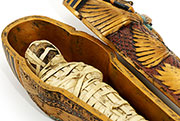- Navigating Your Midlife Crisis: Embracing New Possibilities
- City Raccoons Showing Signs of Domestication
- Mapping the Exposome: Science Broadens Focus to Environmental Disease Triggers
- One Week Less on Social Media Linked to Better Mental Health
- Your Brain Changes in Stages as You Age, Study Finds
- Some Suicide Victims Show No Typical Warning Signs, Study Finds
- ByHeart Formula Faces Lawsuits After Babies Sickened With Botulism
- Switch to Vegan Diet Could Cut Your Greenhouse Gas Emissions in Half
- Regular Bedtime Does Wonders for Blood Pressure
- Dining Alone Could Mean Worse Nutrition for Seniors
No TV or Obesity, But Ancient People Still Had Heart Disease


They may not have had fast food, TVs or cigarettes, but people of ancient times commonly developed clogged heart arteries — and a new research review speculates on some reasons why.
Using CT scans of mummified remains from ancient Egypt, Peru, the Aleutian Islands and the American Southwest, researchers have found evidence of widespread atherosclerosis — the hardening of heart arteries from fatty substances that build up, eventually leading to heart attack or stroke.
That’s despite the fact that those ancient groups were largely free of today’s perilous lifestyle factors, such as sugar- and fat-laden diets, inactivity, smoking and widespread obesity.
“Our team has evaluated mummies from five different continents. We have yet to find a culture that didn’t have atherosclerosis,” said cardiologist Dr. Gregory Thomas, the lead author of a review published in the current issue of the journal Global Heart.
So, what does that mean for modern times? “These days, we blame ourselves when we or someone in our family develops heart disease,” said Thomas, medical director of the Memorial Care Heart & Vascular Institute at Long Beach Memorial Medical Center in California.
“We say, ‘Well, if you’d just exercised more, you wouldn’t have needed that heart surgery,'” Thomas said. “I think people can stop blaming themselves so much.”
But before you hang up your running shoes and settle down with a bag of chips, Thomas also said that lifestyle still matters. “This doesn’t mean we should stop trying to control risk factors [for heart disease],” he stressed.
Just don’t expect to remain free of heart trouble simply because you jog every day or eat a healthier diet, Thomas said.
Based on what he and an international research team have seen, slightly more than a third of 76 Egyptian mummies had atherosclerosis — and so did a similar percentage of mummies from Peru, the U.S. Southwest and the Aleutian Islands, in the Northern Pacific.
They typically died in what would be considered middle-age today. “It seems like they developed atherosclerosis around the same time that we get it today,” Thomas said. So part of the explanation, he noted, may be age: If you live long enough, fatty deposits will start to build up in the arteries.
Genes are another major factor. “Genetics may account for about half of the risk of heart disease,” Thomas said. “We all have some genetic predisposition to atherosclerosis, regardless of culture or lifestyle.”
But the researchers also speculate about some environmental causes during ancient times. One is exposure to household smoke from cooking fires. Another is the host of infections people were constantly battling — from short-lived bacterial and viral infections, to lifelong parasitic ones.
Thomas explained that even when people managed to survive those ills, the body would be in a continual state of low-grade inflammation, which is part of the immune system’s response to invaders.
And that’s in line with what scientists today suspect: Chronic inflammation contributes to atherosclerosis.
It’s just that today, the primary causes of that inflammation may be different, said Dr. Suzanne Steinbaum, director of Women’s Heart Health at Lenox Hill Hospital in New York City.
Modern factors may include diet and sleep loss — but there could be a range of yet unknown contributors, according to Steinbaum, who was not involved in the new research.
“This study reminds us that we need to keep looking at aspects of modern life that could be contributing to inflammation,” Steinbaum said.
Thomas acknowledged that in Egypt, mummification was an elaborate and expensive process. So those remains would represent the upper class at the time — people who might have enjoyed indulgent diets and ample lounging time.
But Thomas said the remains from some other cultures likely represent the “common person” — such as the Aleutian hunter-gatherers, who probably did not spend much time lounging and eating.
More information
The U.S. National Institutes of Health has more on heart disease risk factors.
Source: HealthDay
Copyright © 2025 HealthDay. All rights reserved.










